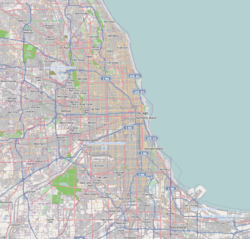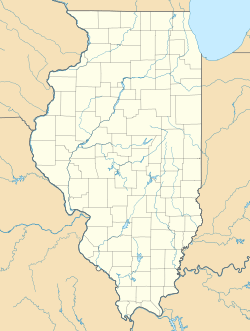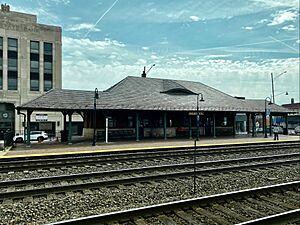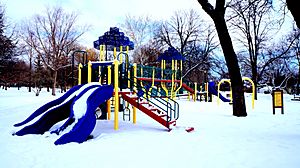Berwyn, Illinois facts for kids
Quick facts for kids
Berwyn, Illinois
|
|||
|---|---|---|---|
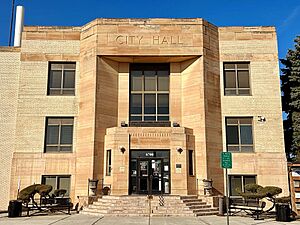
Berwyn City Hall, listed on the National Register of Historic Places.
|
|||
|
|||
| Nickname(s):
The City of Homes
|
|||
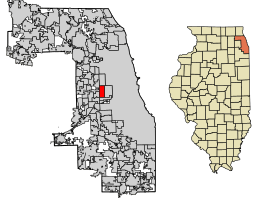
Location of Berwyn in Cook County, Illinois.
|
|||
| Country | |||
| State | |||
| County | Cook | ||
| Township | Berwyn | ||
| Incorporated | 1908 | ||
| Government | |||
| • Type | Mayor–council | ||
| Area | |||
| • Total | 3.90 sq mi (10.11 km2) | ||
| • Land | 3.90 sq mi (10.11 km2) | ||
| • Water | 0.00 sq mi (0.00 km2) 0% | ||
| Population
(2020)
|
|||
| • Total | 57,250 | ||
| • Density | 14,664.45/sq mi (5,661.31/km2) | ||
| Up 4.9% from 2000 | |||
| Standard of living (2018-2022) | |||
| • Per capita income | $31,736 | ||
| • Median home value | $272,900 | ||
| ZIP code(s) |
60402
|
||
| Area code(s) | 708/464 | ||
| Geocode | 17-05573 | ||
| FIPS code | 17-05573 | ||
Berwyn is a city located in Cook County, Illinois, in the United States. It is a suburb that is part of the larger Chicago metropolitan area. Berwyn became an official city in 1908. As of the 2020 census, about 57,250 people live there. It is sometimes called "The City of Homes" because of its many unique houses.
Contents
Exploring Berwyn's Past
Before Berwyn became a city, Native American trails crossed the land. Two important trails, a branch of the Trail to Green Bay and the Ottawa Trail, went through what is now Berwyn. These trails were used for trade and travel.
How Berwyn Began
In 1846, Theodore Doty was the first person to own land in this area. He built an 8-foot-wide road from Chicago to Ottawa. This road is now known as Ogden Avenue in South Berwyn.
Later, in 1856, Thomas F. Baldwin bought a large piece of land. He hoped to create a fancy community called "LaVergne." But the land was often muddy and flooded, so not many people wanted to move there. The only way to get around was by horse and buggy.
The Railroad Arrives
To help LaVergne grow, Baldwin sold land to the Burlington and Quincy Railroad in 1862. The train line opened in 1864. At first, trains did not stop often. So, in 1874, the people living there built their own train station called LaVergne Station.
After Baldwin passed away, his daughter sold most of the land to a group of realtors in 1879. This new group set rules for building homes. They wanted houses to be well-built and cost a certain amount. By 1880, 12 new homes were built. The first public building, LaVergne School, opened in 1888.
Naming the City
In 1890, two lawyers, Charles E. Piper and Wilbur J. Andrews, bought more land to develop. They wanted the railroad to build a station for them. Since the railroad already had stations nearby, Piper and Andrews decided to build their own station.
They looked at a train schedule from Pennsylvania to find a name for their station. They chose "Berwyn" after a beautiful suburb of Philadelphia. After 1901, all the settlements in the area became known as Berwyn.
Building Homes in Berwyn
During the 1920s, Berwyn grew very quickly. The city had strict rules for building. This led to many well-built, two-story brick houses called bungalows. Many of these homes have special details like stained glass windows and unique brick patterns. Today, Berwyn is famous for having one of the largest collections of these Chicago-style bungalows in the country.
Who Lives in Berwyn?
| Historical population | |||
|---|---|---|---|
| Census | Pop. | %± | |
| 1910 | 5,841 | — | |
| 1920 | 14,150 | 142.3% | |
| 1930 | 47,027 | 232.3% | |
| 1940 | 48,451 | 3.0% | |
| 1950 | 51,280 | 5.8% | |
| 1960 | 54,224 | 5.7% | |
| 1970 | 52,502 | −3.2% | |
| 1980 | 46,849 | −10.8% | |
| 1990 | 45,426 | −3.0% | |
| 2000 | 54,016 | 18.9% | |
| 2010 | 56,657 | 4.9% | |
| 2020 | 57,250 | 1.0% | |
| U.S. Decennial Census 2010 2020 |
|||
As of the 2020 Census, Berwyn had 57,250 people living in it. This means many people live close together. Berwyn has one of the highest population densities (how many people live in a certain area) of any township in Illinois.
Berwyn is a very diverse city. Many different cultures and backgrounds make up its population. For example, a large part of the population is of Hispanic or Latino heritage. The top ancestries reported in the city are Mexican and Puerto Rican. Other groups include people of Polish, German, Irish, Italian, and Filipino descent.
The average age in Berwyn is about 35.6 years old. About 26.1% of the people are under 18 years old.
Berwyn's Location and Surroundings
Berwyn covers about 3.90 square miles of land. It is bordered by several other cities. These include Oak Park to the north and Cicero to the east.
Long ago, the land where Berwyn is now was mostly grassy marshland. There was a shallow waterway called Mud Lake that connected to the Chicago River. This area often flooded during heavy rains in Berwyn's early years.
Learning in Berwyn
Berwyn has several schools for students from kindergarten to 8th grade. These are divided into two main school districts:
- Berwyn North School District 98 has four schools.
- Berwyn South School District 100 has eight schools.
For high school, students attend one of two schools: J. Sterling Morton High School West in Berwyn or J. Sterling Morton High School East in Cicero. Which school they attend depends on where they live in Berwyn.
There is also a Catholic school, St. Leonard School, for students from pre-kindergarten to 8th grade.
Historic Schools
LaVergne School was the very first school built in Berwyn in 1888. It had two classrooms with fireplaces. Even though people protested, the building was torn down in 1938. A new building, the Lavergne Education Centre, was built in its place. It is now the main office for the Berwyn South School District 100.
Berwyn's Economy
Berwyn is known as the "City of Homes," but it also has busy business areas. These include Ogden Avenue, the Depot District, Cermak Road, and Roosevelt Road.
Business Hubs
- Ogden Avenue: This road is part of historic Route 66. It used to have many car dealerships.
- The Depot District: This area is around the train station. It has many local shops and restaurants. Loyola MacNeal Hospital, founded in 1919, is the biggest employer in the city and is located here.
- Cermak Road: This road was once called "The Bohemian Wall Street" because it had many banks. In 1991, a newspaper reported that Berwyn had the most banks in the world for its size.
- Cermak Plaza Shopping Center: This shopping center opened in 1956. It was the main shopping spot until a larger mall opened nearby in 1975. Today, Cermak Road still has many shops and restaurants.
Top Employers
Here are some of the biggest employers in Berwyn:
| # | Employer | # of Employees |
|---|---|---|
| 1 | Loyola MacNeal Hospital | 2,200 |
| 2 | J. Sterling Morton High School District 201 | 1,000 |
| 3 | City of Berwyn | 550 |
| 4 | Berwyn South School District 100 | 456 |
| 5 | Berwyn North School District 98 | 370 |
| 6 | Campagna-Turano Baking Company | 300 |
Getting Around Berwyn
Train Travel
Berwyn has train service on the BNSF Line. Metra operates three train stations in the city: Harlem Avenue station, Berwyn Station, and La Vergne station.
Bus Service
Bus service in Berwyn and to nearby towns is mainly provided by Pace Bus. The CTA also has a bus route (Route 21) that goes through Berwyn on Cermak Road.
Walking and Environment
Berwyn is known for its walkable neighborhoods. This means people can easily walk to stores and other places. Because of its smaller homes and easy access to services, Berwyn residents can live a lifestyle that produces less carbon pollution. This is good for the environment.
Arts and Fun in Berwyn
Berwyn has a growing arts scene. It has a professional theater, an Arts Council, and places for music and entertainment. The 16th Street Theater, which puts on live shows, opened in 2007.
Yearly Events
- Houby Day Parade: From the 1920s to the 1970s, many people from Czechoslovakia lived in Berwyn. To celebrate their heritage, the Houby Day Parade started in 1968. "Houby" means "mushrooms" in Czech, and the parade happens during the fall mushroom harvest.
- Vintage Car Show: Ogden Avenue in Berwyn is part of historic Route 66. Since 1990, an annual Vintage Car Show takes place every September. Hundreds of car fans come to see classic cars.
- Cartopia: Since 2006, Berwyn has hosted an annual art car parade called Cartopia. Artists from all over the country show off their creative "art cars" and parade them through the neighborhood.
- Oktoberfest and Brew Fest: Since 2000, Berwyn has held an Oktoberfest and a Brew Fest in mid-to-late September.
Public Art
Berwyn was once famous for a sculpture called Spindle. This artwork, created by Dustin Shuler, showed several cars stacked on a giant spike. It was located in the Cermak Plaza shopping center and even appeared in the 1992 movie Wayne's World. Sadly, the Spindle was taken down in 2008.
Since 2019, the city has worked with the Berwyn Public Art Initiative. This group helps independent artists create new public art throughout the city.
Berwyn in Movies and TV
Berwyn has been a filming location for several movies and TV shows:
- Parts of the 2008 movie Wanted were filmed at Cermak Plaza.
- Scenes from A League of Their Own, The Color of Money, and Adventures in Babysitting were filmed at FitzGerald's Nightclub in Berwyn.
- Berwyn is often mentioned in the Chicago TV series Svengoolie as a running joke.
- Berwyn has also been a backdrop for TV shows like the Dick Wolf Chicago series, The Chi, and Empire.
Parks and Recreation
Berwyn has many parks and community centers. Two park districts and a recreation department manage these places. They also organize sports leagues and activities for kids, teens, and adults.
Proksa Park
The city's largest park is Proksa Park, which is about 15 acres in size. It has many flower beds, different kinds of trees and shrubs, a small pond, and a stream. You can also find tennis courts, softball fields, and a large playground there.
Pav YMCA
Berwyn is also home to the Pav YMCA. It opened in 1987 and has an Olympic-sized indoor swimming pool, courts for racquetball and handball, a gym, and exercise areas.
List of Parks
Here is a list of Berwyn's public parks and recreation centers:
| North Berwyn Park District | Berwyn Park District | Berwyn Recreation Department | |||
|---|---|---|---|---|---|
| Community Center / Pyrce Park | 16th and Wesley | Freedom Park | 3701 Scoville | Rec Center / Pavek Pool | 6501 W. 31st |
| Berwyn Gardens | Maple and Cermak | Friendship Park | 25th and Kenilworth | Janura Park | 28th and East |
| Jefferson Field | 16th and Wenonah | Hessler Park | 34th and Kenilworth | Baseball Alley | East Ave. and 29th |
| Kriz Park | 15th and Maple | Karasek Park | Windsor and Kenilworth | Karban Park | East and Ogden Alleys |
| Hett Park | 19th and Cuyler | Liberty Cultural Center | 6445 W. 27th Pl | ||
| Mraz Park | Oak Park and Riverside Dr | ||||
| Proksa Park | 3001 S. Wisconsin | ||||
| Serenity Park | Wesley and 26th | ||||
| Smirz Park | 34th and Highland | ||||
| Sunshine Park | 29th and Oak Park | ||||
| Unity Park | 25th and Cuyler | ||||
Cool Facts About Berwyn
Berwyn is a very diverse community. It has larger homes on its south side and many smaller, bungalow-style homes on the north side. Because of its many smaller homes, Berwyn has a very low carbon footprint. This means the city's homes and cars produce less carbon dioxide compared to other areas.
Berwyn is also home to one of the world's largest laundromats! It is 13,500 square feet in size and has 161 washers and 140 dryers. It even has a kids' play area, big screen TVs, and a bird sanctuary. This laundromat is special because it uses a solar thermal system to heat its water, which is good for the environment.
Famous People From Berwyn
Many notable people have connections to Berwyn:
- Jeff Adams, football player
- Scarlett Bordeaux, professional wrestler
- Richard Christiansen, film and theatre critic
- Ray Clay, former Chicago Bulls announcer
- Allan Cox, author and business leader
- Joey Goodspeed, football player for the Minnesota Vikings and other teams
- Brian Gutiérrez, soccer player for Chicago Fire FC
- Ozzie Guillén, Major League Baseball player and manager
- Gary Hallberg, golfer
- David Huffman, actor
- Fred Malek, businessman
- Stan Mikita, professional hockey player for the Chicago Blackhawks
- Bob Miller, pitcher for the Detroit Tigers and other teams
- Arthur Nielsen, market analyst who founded ACNielsen
- Bob Odenkirk, actor and comedian (known for Breaking Bad)
- Jim Peterik, musician, founding member of The Ides of March and Survivor
- Sondra Radvanovsky, opera singer
- Iman Shumpert, professional basketball player
- Jerry Wainwright, college basketball coach
- Dave Wehrmeister, pitcher for the San Diego Padres and other teams
- Bob Will, outfielder for the Chicago Cubs
Images for kids
See also
 In Spanish: Berwyn (Illinois) para niños
In Spanish: Berwyn (Illinois) para niños




